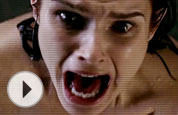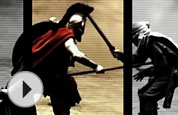Luminosity is the best fan that shows like Friday Night Lights, Highlander, Farscape, and Buffy ever had—but she can’t use her real name in this interview for fear that their producers will sue her. As a vidder—a director of passionate tributes and critiques of her favorite shows—Luminosity samples video in order to remix and reinterpret it, bending source material to her own purposes. “Much of contemporary remix culture falls back on parody,” explains MIT professor Henry Jenkins, author of Convergence Culture: Where Old and New Media Collide, “but these fan videos seek to convey the emotional intensity [that they feel]. They communicate more if you know the shows on which they are based but they can stand alone as mood poems or character sketches.” We emailed with Luminosity about her meticulously crafted videos, including Women’s Work, her loving critique of violence in Supernatural, and Vogue/300, her hysterical riff on those hunky Spartans.
I think many of our readers won’t be familiar with “vidding.” Could you tell me what it is?
The quick and easy description: Vids are fan-made music videos. We create them using scenes taken from our favorite TV shows and movies, pairing them with a particular piece of music and imposing our own video-editing choices and style. The motivation for a lot of us is to convey something deeply felt about the show.
Most people became aware of vidding with YouTube, but there’s a longer history to it, right?
Vidding started in 1975 with Kandy Fong, a Star Trek fan, who made the first ever vid, at a convention, by setting a slideshow to music. Almost as soon as VCRs became available, fans started using them to make vids, which were shown mainly at fan conventions or passed around on tape by mail. Computers and the Internet have made it a lot easier both to make vids and to share them—now everyone wants to make things like vids. Vidding is not a static art form. It is subject to waves and schools, just like any other art. It may have started with parody, but now it has progressed, I think, into modern and postmodern interpretations of the source.
Women done more vidding than men historically.
Yes! Everyone’s always surprised when I tell them this, but most vidders are women; then again, film editing was historically a female job. There are maybe five men who attend the primary annual vidding convention.
TV and film are still dominated by male creators behind the camera. Is this part of what you’re reacting to?
Vidding is one of the central parts of media fandom, the creative responses of initially mostly female fans to TV shows and films. So, yes, at its very core, our entire history is tied into talking back to male creators, teasing out for ourselves and telling the stories we don’t get otherwise. But when all said and done, the gender of the creator(s) isn’t that important to me. What’s important is how I change it.
I don’t know much about you, in part because you don’t use your real name.
I’ve been “Luminosity” since Fidonet and Echonet back in the eighties, and pseudonyms are very common on the Internet; but yes, there is some concern about copyright issues. But when I make a Buffy vid, no one is going to mistake me for Joss Whedon. If anything, vids provide free advertising. I wish the industry would join us in the 21st century. As we speak, a group of fans are putting together a new nonprofit, the Organization for Transformative Works, which will be working to help protect the fair-use rights of fan creators to make vids and fanfic.
How did you get started?
I saw a vid for the first time in 1996, I hit critical mass in 2000, bought the hardware and software, found a couple of generous and talented vidders to point me in the right direction, and I was off and running. The first show that inspired me to vid was Highlander: The Series. I was emotionally invested in the fandom and the show, it had viable canonical continuity, and it was beautifully filmed. Not everyone vids for the same reasons that I vid. I vid for the Big Emotion.
How do vidders find one another?
I could tell you, but then I’d have to kill you—no, seriously, this is a highly contested issue within the vidding community. Even though we believe our work is legitimate and transformative art, a lot of vidders prefer to stay out of the spotlight until the legal situation is clearer. More recently, though, some vidders have decided to go a bit more public, and so you can find my work and that of some other vidders on video streaming sites like Imeem or Stage6.
Your biggest work is Scooby Road, which remixes scenes from Buffy and scores them to the entire Beatles Abbey Road LP.
Before Scooby Road, it was as if we vidders were making “singles.” No one had made an album-length “concept vid” yet. I love the Beatles, and I felt that making every song in an album relate in some way to Buffy was a challenge I could meet.
What filmmakers and TV directors do you most admire?
My favorites were the film noir directors of the forties and fifties— Orson Welles, Jacques Tourneur. On TV, I admire David Nutter, Kim and Kelly Manners, and Joss Whedon. While I admire directors from afar, I study cinematographers and film editors up close. I have a black-and-white vid in the works because I want to learn to “see” in black and white, the way those cinematographers like John Seitz and Stanley Cortez did in the forties.
We’re featuring Vogue/300. There have been many riffs on the film 300—one set to “It’s Raining Men”—and lots of parodies. But yours is on a whole other level.
It was my chance to do a bait and switch, and turn the “male gaze” back onto itself. I wanted to allude to the graphic novel, so I split the screens and tinted them with flat color. The movie was visually stunning as well, and it’s always fun to work with pretty source.
We’re also featuring Women’s Work, which seems like a fairly severe critique of the treatment of women on Supernatural. But its beauty also seems to complicate the critique. You told me your heart “belongs to Dean and Sam.”
Women’s Work is a critique of the eroticization of the violence done to women in all media, not just Supernatural. Women are sexually assaulted, murdered, and then laid out in artistic tableaux, chopped into pretty, bloody pieces. They usually further the plot, but they’re hardly ever a part of the plot. We wanted to point out that in order for us to love a TV show—and we do—we have to set this horrible part of it aside. A lot. Often. Sisabet [the co-vidder of the project] and I believe that we could have made this vid using almost any show, from Heroes to CSI, but we are fans of Supernatural. We care so much about a show that we want share it, make an argument, highlight a character or situation, lampoon something, evoke a mood. I’ve also made four other Supernatural vids that celebrate the show, the arc, the relationship between the brothers and the genre itself.


Vogue/300